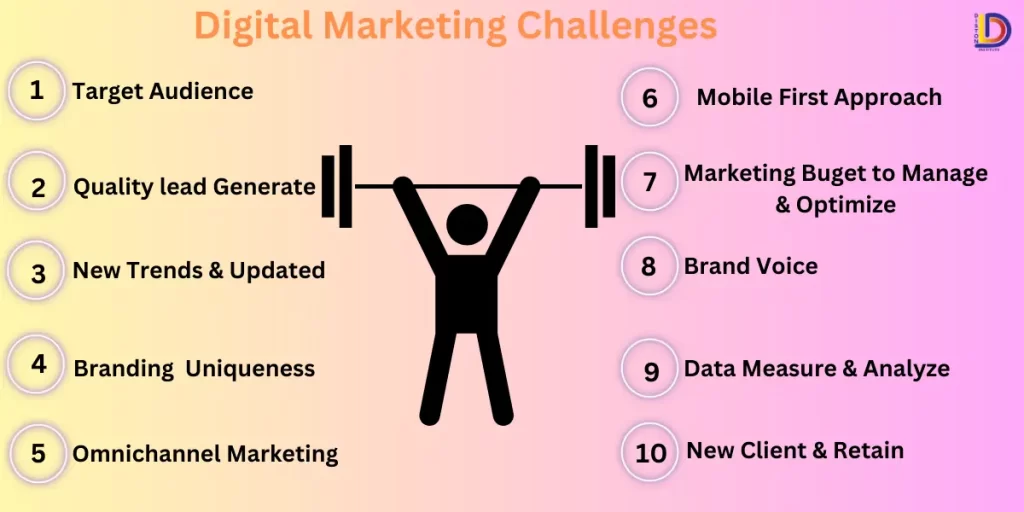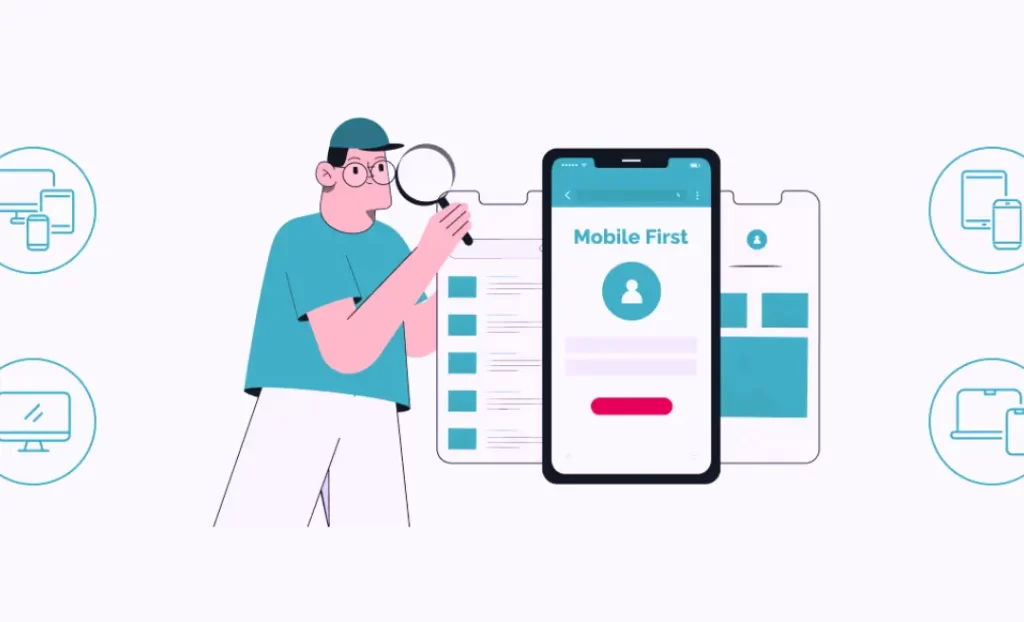Top 10 Challenges in Digital Marketing leverages digital channels to connect with current and prospective customers, with the ultimate goal of driving traffic to websites, generating leads, and converting leads into customers.
Digital marketing is essential for businesses of all sizes to reach and engage their target audiences effectively in the digital age. By leveraging SEO, PPC advertising, content marketing, social media, email marketing, marketing automation, and data analytics, marketers can create integrated strategies that drive business growth and achieve marketing objectives. Digital marketing continues to evolve with advancements in technology and changes in consumer behavior, requiring marketers to stay agile, innovative, and data-driven to succeed in competitive markets.

Digital Marketing
Digital marketing , while highly effective, comes with its own set of challenges. Here are the top 10 challenges commonly faced by digital marketers today:
Constantly Changing Algorithms: Platforms like Google and social media channels frequently update their algorithms, impacting organic reach and SEO strategies.
Increased Competition: With the low barrier to entry, more businesses are entering digital marketing, making it harder to stand out and reach target audiences.
- Data Privacy Concerns: Stricter regulations (e.g., GDPR, CCPA) require businesses to handle customer data responsibly, impacting targeting and personalized marketing efforts.
- Ad Blocking: The rise of ad-blocking software limits the visibility of paid advertisements, reducing their effectiveness and requiring more creative approaches.
- Measuring ROI: Determining the return on investment (ROI) for digital marketing campaigns can be challenging due to the complexity of tracking conversions across multiple channels.
- Content Saturation: There’s an overwhelming amount of content online, making it difficult to create unique, valuable content that captures and retains audience attention.
- Short Attention Spans: Consumers have increasingly shorter attention spans, requiring marketers to deliver concise and engaging content that quickly communicates value.
- Multichannel Coordination: Managing and optimizing campaigns across multiple digital channels (e.g., social media, email, SEO) requires coordination and integration for consistent messaging.
- Technology Integration: Implementing and integrating various marketing technologies (e.g., CRM systems, analytics tools, automation platforms) can be complex and resource-intensive.
- Skill Gaps and Training: The rapid evolution of digital marketing requires continuous learning and upskilling to stay abreast of new trends, technologies, and best practices.
- Addressing these challenges requires strategic planning, flexibility, and a deep understanding of both digital marketing principles and evolving consumer behaviors. Successful marketers navigate these obstacles by leveraging data-driven insights, staying adaptable to industry changes, and prioritizing customer-centric approaches
1.Target Audience
In digital marketing, identifying and understanding the target audience is essential for crafting effective campaigns that resonate with potential customers online. The challenges in digital marketing are faced. Here are some key aspects of defining the target audience in the context of digital marketing:
- Demographics: This includes factors such as age, gender, income, education, occupation, marital status, and location. Understanding these demographics helps in targeting specific groups more accurately.
- Psychographics: This involves understanding the lifestyle, interests, values, attitudes, and behaviors of your audience. This information can be gathered through social media insights, surveys, and data analytics tools.
- Behavioral Data: Analyzing online behavior such as browsing history, purchase history, engagement with content, and interactions with ads provides valuable insights into consumer preferences and decision-making patterns.
- Technographic Information: This includes understanding what devices your audience uses (desktops, mobile devices, tablets), which operating systems they prefer, and their internet usage habits. This helps in optimizing digital experiences accordingly.
- Social Media Insights: Platforms like Facebook, Instagram, and LinkedIn offer detailed audience analytics that can provide insights into who is interacting with your content, their demographics, interests, and behaviors.
- Search Behavior: Analyzing search engine queries and keywords related to your product or service helps understand what potential customers are looking for and how they express their needs online.
- Buyer Personas: Developing detailed buyer personas based on research and data helps create a clear picture of your ideal customers. Each persona represents a segment of your target audience with specific characteristics and motivations.
- Segmentation: Segmenting your audience into smaller, more specific groups based on shared characteristics allows for more personalized and targeted marketing strategies. This can lead the higher engagement and conversion rates.
Overall, in digital marketing, the more precisely you define and understand your target audience, the more effectively you can tailor your content, messaging, offers, and advertising efforts to meet their needs and preferences. This approach enhances the overall effectiveness and efficiency of your digital marketing campaigns.

2.Quality Leads Generate
Generating quality leads in digital marketing involves several strategies and tactics aimed at attracting potential customers who are more likely to convert into paying customers. The challenges in digital marketing are faced. Here are some key methods to generate quality leads:
- Targeted Advertising: Use targeted advertising on platforms like Google Ads, Facebook Ads, LinkedIn Ads, etc., to reach specific demographics, interests, and behaviors that align with your ideal customer profile. This ensures your ads are seen by those most likely to be interested in your products or services.
- Content Marketing: Create high-quality, valuable content such as blog posts, ebooks, whitepapers, webinars, and videos that address pain points and provide solutions for your target audience. Content marketing not only attracts potential leads but also establishes your brand as an authority in your industry.
- Search Engine Optimization (SEO): Optimize the website and content for search engines to attract the organic traffic. Focus on relevant keywords, create useful content that answers search queries, and improve your site’s user experience to increase visibility and attract leads who are actively searching for solutions.
- Email Marketing: Nurture leads through targeted email campaigns that provide valuable content, special offers, and personalized messages based on their interests and behaviors. Segment your email list to tailor messages to different stages of the buyer’s journey.
- Social Media Engagement: Engage with your audience on social media platforms where they are active. Share useful content, respond to comments and messages, and participate in discussions to build relationships and trust with potential leads.
- Lead Magnets: Offer valuable resources such as ebooks, guides, templates, or free trials in exchange for contact information. This allows you to capture leads who are interested in your offerings and willing to exchange their information for valuable content.
- Landing Pages: Create optimized landing pages that clearly communicate the value proposition of your offer and encourage visitors to take a specific action, such as signing up for a webinar or downloading an ebook.
- Lead Scoring and Segmentation: Implement lead scoring based on criteria such as engagement level, demographics, and behavior to prioritize leads who are more likely to convert. Segment leads into different categories based on their interests and readiness to purchase.
- Analytics and Optimization: Use analytics tools to track the performance of your lead generation efforts. Analyze data such as conversion rates, traffic sources, and engagement metrics to identify what’s working and optimize your campaigns accordingly.
By implementing these strategies effectively, digital marketers can attract, nurture, and convert quality leads that are more likely to become long-term customers, thereby driving business growth and profitability

3.New Trends & Stay Updated
Digital marketing is a rapidly evolving field, and staying updated with the latest trends and innovations is crucial for marketers to remain competitive and effective. The challenges in digital marketing are faced. Here are some new trends and updates in digital marketing as of 2024:
- Artificial Intelligence (AI) and Machine Learning: AI and machine learning continue to transform digital marketing by enabling more personalized customer experiences, predictive analytics, chatbots for customer service, and automation of repetitive tasks such as email campaigns and ad optimization.
- Voice Search Optimization: With the rise of smart speakers and voice assistants like Siri, Alexa, and Google Assistant, optimizing content for voice search has become essential. Marketers need to focus on natural language keywords and conversational queries.
- Video Marketing Dominance: The Video content remains a dominant force in the digital marketing. Short-form videos on platforms like TikTok and Instagram Reels, live streaming, and interactive video content are gaining popularity for engaging audiences and conveying brand messages effectively.
- Influencer Marketing Evolution: Influencer marketing has evolved beyond celebrity endorsements to include micro and nano influencers who have smaller, highly engaged audiences. Authenticity, relevance, and long-term partnerships are becoming more important in influencer collaborations.
- Privacy and Data Protection: With increasing concerns about data privacy, marketers need to prioritize compliance with regulations like GDPR and CCPA. Building trust with customers through transparent data practices and secure handling of personal information is crucial.
- Augmented Reality (AR) and Virtual Reality (VR): AR and VR technologies are being used in marketing to enhance customer experiences, allow virtual product try-ons, create immersive brand experiences, and increase engagement through interactive content.
- Ephemeral Content: Content that is available only for a short period (24 hours) on platforms like Snapchat Stories and Instagram Stories is gaining popularity. It creates a sense of urgency and encourages immediate engagement from users.
- Personalization at Scale: Advanced data analytics and AI-driven technologies enable marketers to deliver highly personalized experiences at scale. This includes personalized recommendations, content customization, and dynamic email content based on user behavior and preferences.
- Interactive Content: Interactive content such as quizzes, polls, calculators, and interactive infographics engages users actively, encourages participation, and provides valuable insights into customer preferences and behaviors.
- Sustainability and Social Responsibility: Consumers are increasingly prioritizing brands that demonstrate commitment to sustainability and social responsibility. Digital marketing strategies that highlight eco-friendly practices, ethical sourcing, and community involvement resonate well with environmentally conscious consumers.
Keeping abreast of these trends and integrating relevant ones into your digital marketing strategy can help you stay ahead of the curve, attract and retain customers effectively, and drive business growth in the digital landscape of 2024 and beyond.

4.Brand Uniqueness
Brand uniqueness in digital marketing refers to the distinctive qualities and characteristics that set a brand apart from its competitors in the online space. Achieving brand uniqueness is crucial in a crowded digital marketplace where numerous businesses are vying for consumer attention. Here are several key aspects to consider in cultivating brand uniqueness in digital marketing:
- Brand Identity: Develop a clear and consistent brand identity that reflects your company’s values, mission, and personality. This may includes your logo, color scheme, typography, and the overall visual style.
- Unique Value Proposition (UVP): Clearly articulate what makes your brand unique and why consumers should choose your products or services over others. Your UVP should be the address of the specific needs and pain the points of your target audience.
- Content Strategy: The Create compelling and valuable content that resonates with your audience. This can include blog posts, videos, infographics, podcasts, and social media posts. Your content should reflect your brand’s voice and offer insights or solutions that differentiate you from competitors.
- Customer Experience: Focus on providing an exceptional customer experience across all digital touchpoints. This includes your website usability, customer service responsiveness, and personalized interactions.
- Innovative Approach: Embrace innovation in your digital marketing strategies. Experiment with new technologies, platforms, or formats to engage your audience in unique ways that competitors may not be utilizing.
- Consistency Across Channels: Ensure consistency in messaging and brand representation across all digital channels. This helps reinforce your brand identity and build trust with your audience.
- Authenticity and Transparency: Be authentic in your communications and transparent about your brand values, processes, and product offerings. Authenticity resonates with the consumers and helps to build the long-term relationships.
- Emotional Connection: Foster an emotional connection with your audience by telling compelling stories or aligning with causes that matter to them. Emotional resonance can create a strong bond and loyalty toward your brand.
- Monitor Competitors: Stay informed about your competitors’ digital marketing efforts. Identify gaps or opportunities where you can differentiate your brand further.
- Feedback and Adaptation: You Should Listen to the customer feedback and adapt your strategies accordingly. Continuous improvement based on insights from your audience can help refine your brand’s uniqueness over time.
By focusing on these aspects, brands can establish a distinct presence in digital marketing, attract their target audience, and build a loyal customer base.

5.Omnichannel Marketing Strategy
Building an effective omnichannel marketing strategy in digital marketing involves integrating various online channels to deliver a seamless and personalized experience to customers. The challenges in digital marketing are faced. Here’s a structured approach to follow:
- Customer-Centric Approach: Understanding your target audience deeply. Analyze their preferences, behaviors, and how they engage with different digital channels (e.g., website, social media, email).
- Unified Brand Experience: Ensure consistent branding across all digital channels. Maintain uniformity in messaging, visuals, tone of voice, and overall brand identity to reinforce brand recognition and trust.
- Integrate Data and Systems: Implement technologies that allow you to collect, analyze, and use customer data effectively across channels. This unified data approach helps in delivering personalized experiences and tracking customer journeys seamlessly.
- Responsive Design: Optimize your website and digital assets for responsiveness across devices (desktops, tablets, mobiles). Ensure a smooth user experience regardless of the device used, enhancing accessibility and engagement.
- Content Strategy: Develop a cohesive content strategy that resonates with your audience across different channels. Tailor content formats (blogs, videos, infographics) to suit each channel’s dynamics while maintaining consistency in messaging.
- Email Marketing Integration: Integrate email marketing efforts with other channels. Use data insights to personalize email campaigns based on user behavior on your website or interactions with other channels.
- Social Media Engagement: Leverage social media platforms strategically to engage with your audience. Use analytics to understand which platforms your audience prefers and tailor content and messaging accordingly.
- Paid Advertising Alignment: Coordinate paid advertising campaigns (PPC, display ads, social ads) across channels to reinforce messaging and maximize reach. Use data-driven insights to optimize ad targeting and budget allocation.
- Customer Service Integration: Ensure seamless customer service across digital channels. Implement chatbots, live chat features, or AI-driven customer service tools to provide timely support and enhance customer satisfaction.
- Measurement and Optimization: Continuously monitor and measure the performance of each channel and campaign. Use analytics to track key performance indicators (KPIs) such as conversion rates, engagement metrics, and ROI. Optimize your strategies based on data insights to improve results over time.
- Adaptability and Innovation: Stay agile and adaptable to changes in technology and consumer behavior. Experiment with new channels, technologies, or digital marketing tactics to innovate and stay ahead of competitors.
- Cross-Channel Coordination: Foster collaboration across teams (marketing, sales, customer service) to ensure alignment and coherence in your omnichannel strategy. Encourage shared goals and strategies to deliver a unified brand experience.
By following these steps, businesses can develop a robust omnichannel marketing strategy in digital marketing that enhances customer engagement, loyalty, and ultimately drives business growth.

6.Mobile First Approach
A “mobile-first” approach in digital marketing focuses on prioritizing the mobile user experience above all other platforms. This strategy acknowledges the significant shift towards mobile usage for internet browsing, social media engagement, and online shopping. The challenges in digital marketing are faced. Here are key elements to consider when implementing a mobile-first approach in digital marketing:
- Responsive Web Design: Ensure your website is responsive and mobile-friendly. This means the site should adapt seamlessly to different screen sizes and resolutions, providing a consistent user experience across desktops, tablets, and smartphones.
- Page Speed Optimization: Mobile users expect fast-loading websites. Optimize your site’s speed by compressing images, minifying code, leveraging browser caching, and using content delivery networks (CDNs).
- Mobile SEO: Optimize your website and content for mobile search engines. This includes using mobile-friendly keywords, optimizing meta tags, and ensuring your site’s structure is conducive to mobile indexing.
- Mobile-Optimized Content: Tailor your content for mobile consumption. Keep paragraphs short, use bullet points and headers to break up text, and ensure readability on smaller screens. Video content should also be optimized for mobile viewing.
- Mobile App Optimization: If you have a mobile app, optimize its usability and performance. Encourage app downloads through targeted app store optimization (ASO) strategies and promote engagement through push notifications and in-app messaging.
- Local Optimization: Mobile searches often have local intent. Optimize your digital presence for local SEO by claiming and optimizing your Google My Business listing and ensuring consistency across local directories.
- Mobile-Friendly Ads: Design advertisements that are optimized for mobile devices. Use clear calls-to-action (CTAs), concise messaging, and visually appealing formats that work well on smaller screens.
- Social Media Engagement: Focus on mobile-friendly social media strategies. Ensure your content is easy to consume on mobile platforms like Facebook, Instagram, Twitter, and LinkedIn. Utilize mobile-specific features such as Stories and in-feed advertisements.
- Mobile Payment Options: Simplify the mobile purchasing process by offering mobile-friendly payment options. Ensure your checkout process is streamlined, secure, and optimized for mobile users.
- Analytics and Testing: Use mobile analytics to track user behavior and engagement metrics. A/B test different mobile strategies and designs to optimize performance continuously.
- Voice Search Optimization: With the rise of voice assistants on mobile devices, optimize your content for voice search queries. Use conversational language and answer commonly asked questions related to your products or services.
- User Experience (UX) Design: Prioritize user experience in your mobile design. Ensure navigation is intuitive, buttons are easily clickable, and forms are simplified for touchscreens.
By adopting a mobile-first approach in digital marketing, businesses can effectively reach and engage their target audience where they spend a significant amount of their online time—on mobile devices. This approach not only enhances user experience but also improves conversion rates and overall ROI from digital marketing efforts.

7.Marketing Budget to Manage & Optimize
Managing and optimizing a marketing budget for digital marketing involves strategic allocation of resources to achieve the best possible return on investment (ROI). The challenges in digital marketing are faced. Here are key steps and considerations to effectively manage and optimize your digital marketing budget:
- Set Clear Goals: specific, measurable goals for your digital marketing campaigns. Whether it’s increasing the website traffic, generating leads, boosting the sales, or improving brand awareness, clear goals will guide your budget allocation.
- Allocate Budget Across Channels: Distribute your budget across various digital marketing channels based on your audience’s preferences and behavior. Common channels include:
- Search Engine Marketing (SEM) / Pay-Per-Click (PPC) advertising
Social Media Advertising (Facebook, Instagram, LinkedIn, Twitter ads)
Content Marketing (blogging, videos, infographics)
Email Marketing
Influencer Marketing
Display Advertising
SEO (Search Engine Optimization)
Prioritize High-ROI Channels: Identify channels that historically provide a higher return on investment for your business. Allocate a larger portion of your budget to these channels while maintaining a balanced approach across multiple channels for optimal reach and engagement. - Test and Iterate: Implement A/B testing and experimentation to refine your campaigns and optimize budget allocation. Test different ad creatives, targeting options, messaging, and landing pages to identify what resonates best with your audience.
- Monitor Performance Metrics: Use analytics tools to track key performance indicators (KPIs) such as click-through rates, conversion rates, cost per acquisition (CPA), and ROI for each channel. Regularly review performance data to make data-driven decisions on budget adjustments.
- Adjust Budget Allocation: Based on performance insights, reallocate budget to top-performing channels or adjust strategies for underperforming ones. Be flexible and responsive to changes in market trends and audience behavior.
- Focus on Conversion Optimization: Invest in optimizing your conversion funnel to maximize the effectiveness of your budget. Improve landing page design, streamline checkout processes, and implement remarketing strategies to capture and convert leads.
- Budget for Content Creation and Distribution: Allocate resources for creating high-quality content that aligns with your audience’s interests and needs. Budget for content promotion to increase visibility and engagement.
- Consider Seasonality and Campaign Timings: Adjust your budget allocation based on seasonal trends and peak buying periods for your industry. Plan campaigns ahead of time to capitalize on these opportunities effectively.
- Evaluate and Report: Regularly evaluate the overall performance of your digital marketing efforts against your initial goals and budget. Prepare detailed reports to assess ROI and justify budget allocations to stakeholders.
- Stay Updated with Industry Trends: Keep abreast of digital marketing trends, emerging technologies, and best practices. Allocate a portion of your budget for experimenting with new tools and tactics that could enhance your campaigns.
By implementing these strategies, businesses can effectively manage and optimize their digital marketing budget to achieve maximum impact, drive business growth, and maintain a competitive edge in the digital landscape.

8.Brand Voice to Create & Manage
Creating and managing a brand voice in digital marketing involves crafting a consistent personality and tone for your brand across all digital channels. The challenges in digital marketing are faced. Here are some principles and strategies to consider:
- Define Your Brand Personality: Start by identifying adjectives that describe your brand (e.g., friendly, authoritative, witty). This helps in shaping how your brand communicates.
- Understand Your Audience: Firstly, Tailor your brand voice to resonate with your target audience. Consider their demographics, interests, and communication preferences.
- Consistency is Key: Maintain a consistent tone across all platforms and communications. This builds trust and familiarity with your audience.
- Align with Brand Values: Ensure your brand voice reflects the core values and mission of your company. Authenticity is crucial for establishing a genuine connection with customers.
- Adaptability: While consistency is important, be flexible enough to adapt your tone based on the platform and context. For example, your tone on LinkedIn might be more professional compared to Instagram.
- Use Language Appropriately: Pay attention to the language and vocabulary you use. It should be in line with both your brand’s identity and the expectations of your audience.
- Engage and Listen: Use your brand voice to engage with your audience. Encourage conversation, respond to comments, and listen to feedback to refine your approach over time.
- Train Your Team: If you have a team managing your digital marketing efforts, ensure they understand and can apply the brand voice consistently.
- Monitor and Adjust: Regularly monitor how your audience responds to your brand voice. Use analytics and feedback to make adjustments as needed to better meet their expectations.
- Evolve Over Time: As your brand grows and market trends change, your brand voice may evolve. Stay agile and open to refining your approach while staying true to your brand’s essence.
By carefully crafting and managing your brand voice in digital marketing, you can create a cohesive and compelling identity that resonates with your audience and strengthens your brand’s presence online.

9.Data Measure & Analyze
In digital marketing, measuring and analyzing data is crucial for understanding the performance of your campaigns, optimizing strategies, and achieving your business goals. The challenges in digital marketing are faced .Here are some specific types of data to measure and analyze:
- Traffic Sources and Acquisition:
Sources: Identify where your website traffic is coming from (e.g., organic search, paid search, social media, referrals).
Channels: Measure the effectiveness of each channel in driving traffic and conversions.
Campaigns: Track specific campaigns (e.g., email campaigns, social media ads) to see which ones are performing best. - Website Behavior and User Engagement:
Page Views: Monitor how many times each page on your website is viewed.
Goals: Define and track specific goals on your website (e.g., sign-ups, downloads, purchases).
Funnel Analysis: Analyze the steps users take before completing a conversion to identify drop-off points and optimize the conversion process.
Attribution: Determine which marketing channels and touchpoints contribute to conversions. - Email Marketing Metrics:
Click-through Rate (CTR): Track the percentage of recipients who click on links within your emails.
Unsubscribe Rate: Monitor how many recipients opt out of receiving future emails.
Social Media Engagement: - Likes, Shares, Comments: Measure engagement metrics on social media platforms to gauge audience interaction with your content.
- Follower Growth: Track the growth
Reach and Impressions: Understand how many users see your social media posts. - SEO Performance:
- eyword Rankings: Monitor the ranking positions of your targeted keywords in search engine results.
Organic Traffic: Measure the amount of traffic coming to your website through organic search.
Backlinks: Track the number and quality of websites linking to your site. - Customer Data and Insights:
Demographics: Understand the characteristics of your audience (e.g., age, gender, location).
Behavioral Data: Analyze how users interact with your website and marketing campaigns.
Customer Lifetime Value (CLV): Calculate the total revenue generated by a customer over their lifetime to inform marketing strategies. - Competitor Analysis:
Benchmarking: Compare your performance metrics with competitors to identify strengths and weaknesses.
Market Trends: Monitor industry trends and competitor strategies to stay competitive.
Data Visualization and Reporting: - Use dashboards and reporting tools to visualize data and metrics in a clear and actionable format.
Regularly review and analyze data to make data-driven decisions and optimize digital marketing strategies.
By measuring and analyzing these types of data, digital marketers can gain valuable insights into audience behavior, campaign effectiveness, and overall ROI, enabling them to optimize their strategies for better performance and business success.

10.New Client & Retain
Acquiring new clients and retaining them in digital marketing requires a strategic approach that focuses on both attracting prospects and nurturing existing relationships. The challenges in digital marketing are faced. Here’s a comprehensive guide to effectively acquire and retain clients in digital marketing:
Acquiring New Clients:
- Targeted Marketing Campaigns:
- Audience Segmentation: Identify and target specific demographics, interests, and behaviors that align with your ideal client profile.
- Personalized Messaging: Craft personalized content and offers that resonate with your target audience’s pain points and needs.
- Search Engine Optimization (SEO):
- Keyword Optimization: Optimize your website content and blog posts for relevant keywords to attract organic traffic.
- Local SEO: If applicable, optimize for local search to attract clients in your geographic area.
- Pay-Per-Click (PPC) Advertising:
- Targeted Ads: Use PPC platforms like Google Ads and social media ads to target specific demographics and interests.
- Retargeting: Implement retargeting campaigns to re-engage visitors who have shown interest in your services.
- Content Marketing:
- Educational Content: Create valuable content such as blogs, ebooks, and webinars that address your audience’s pain points and establish your expertise.
- Lead Magnets: Offer downloadable resources in exchange for contact information to generate leads.
Social Media Marketing:
Engagement and Interaction: Build relationships with potential clients by engaging with them on social media platforms.
Paid Social Ads: Use targeted advertising on platforms like Facebook, LinkedIn, and Instagram to reach specific audiences.
- Networking and Partnerships:
- Industry Events: Attend and participate in industry events, conferences, and webinars to connect with potential clients.
- Partnerships: The Collaborate with the complementary businesses or influencers to reach new audiences.
Retaining Clients:
Deliver Exceptional Service and Results:
Client Success: Focus on delivering measurable results and exceeding client expectations.
Regular Communication: Maintain open communication to address any concerns and showcase ongoing progress.
- Personalization and Relationship Building:
- Personalized Campaigns: Continue to personalize marketing efforts and communications based on client preferences and behavior.
- Client Feedback: Actively seek feedback and incorporate suggestions to improve services.
- Customer Loyalty Programs:
- Exclusive Offers: Provide special discounts, rewards, or bonuses for loyal clients.
- VIP Treatment: Offer personalized experiences or early access to new services or features.
- Regular Reporting and Transparency:
- Performance Metrics: Provide regular reports detailing campaign performance and ROI to demonstrate value.
- Transparency: Be transparent about strategies, results, and any changes that may impact clients.
- Continuous Improvement:
- Adaptation and Innovation: Stay updated with industry trends and technologies to offer innovative solutions.
- Proactive Strategies: Anticipate client needs and propose proactive strategies to help them achieve their goals.
- Customer Support and Accessibility:
- Responsive Support: Offer timely and efficient customer support through various channels (e.g., email, phone, chat).
- Accessibility: Ensure clients can easily reach out and receive assistance when needed.
- Overall Strategy:
- Integrated Approach: Combine multiple digital marketing tactics to create a cohesive strategy that attracts, converts, and retains clients.
- Data-Driven Decisions: Use analytics and data insights to optimize campaigns, improve client retention strategies, and demonstrate ROI.
- Continuous Evaluation: Regularly assess and refine your client acquisition and retention strategies based on performance metrics and client feedback.
By focusing on both acquiring new clients through targeted marketing efforts and retaining them through exceptional service and personalized strategies, digital marketers can build long-term relationships and achieve sustainable business growth.

Also Read this:- Digital Marketing
